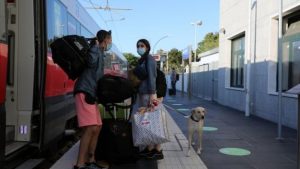Italian Prime Minister Giuseppe Conte offered a hopeful message as the country moved to its final stage in easing lockdown restrictions.

Italians are now allowed to travel inside the country again
“We deserve to smile, to be cheerful, after weeks of great sacrifice,” he said on Wednesday.
He added that now was the time for the country to enact economic reforms.
With more than 33,600 fatalities and almost 234,000 cases since the coronavirus outbreak began, Italy has been one of the hardest-hit countries.
Only the US and the UK have recorded higher death tolls.
Mr Conte’s comments came the same day as the country entered its final phase in easing lockdown restrictions, allowing domestic travel between regions and opening its international borders.
“This crisis must be an opportunity to overcome structural problems and redesign the country,” Mr Conte said. “We have to deal with the economic and social emergency.”
The prime minister said the government was working to speed up social payments and pledged “a serious tax reform”.
But he also continued to urge caution amid the pandemic, noting that “the only effective measures [against the virus] are physical distancing and the use, if necessary, of masks. Abandoning these precautions is seriously thoughtless.”
On the eve of the lifting of restrictions, Italy’s President Sergio Mattarella had also warned that the threat posed by coronavirus had not ended.
“The crisis is not over and institutions and citizens alike will still have to face its consequences and trauma,” he said.
What can Italians do now?
Domestic travel was banned when Italy’s lockdown came into effect in early March, with only a small number of exceptions allowed. Tourism was also prohibited and those entering Italy faced a 14-day quarantine.

Passengers can now travel through Italy by train
But with Wednesday’s changes, Italians are now able to move between regions.
Travel to and from other European countries is also permitted – depending on the rules in the destination country – but non-European travel remains off-limits.
Shops, cafes and restaurants had already opened their doors again, and tourist sites including the Leaning Tower of Pisa and the Colosseum have begun welcoming tourists in recent days.
What’s happening elsewhere in Europe?
While Italy has now opened its international borders, not all of its neighbours have reciprocated. Austria will reopen its borders to all of its neighbours from Thursday – with the sole exception of Italy.
Switzerland, meanwhile, has agreed to lift restrictions with Germany, Austria and France from 15 June, but the government says it is “too early” to introduce similar changes on its border with Italy.
They are not the only European countries exercising caution. Last week, Norway and Denmark announced they would allow travel between the two countries, but excluded Swedes from the deal. Sweden, which did not impose a strict lockdown, has suffered a far higher mortality rate than its Nordic neighbours, and the man behind the policy now says the decision led to too many deaths.
A similar “bubble” has been introduced between three Baltic states – Lithuania, Latvia and Estonia – which became the first countries in Europe to allow free movement again, but only with each other.
Other countries – including the UK and Spain – have introduced a quarantine period for travellers entering the country.



